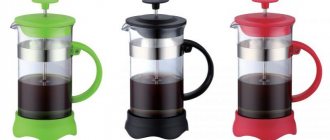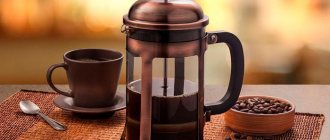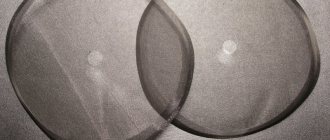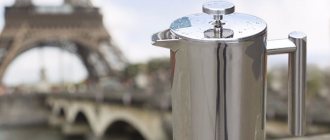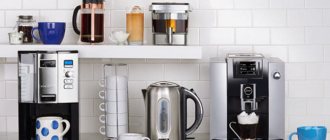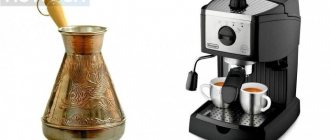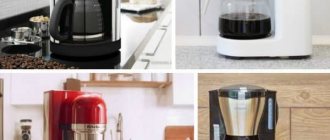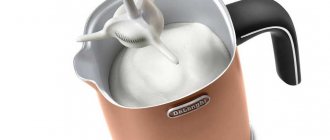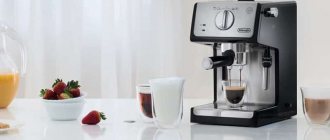A French press is a special device for brewing coffee or tea (see how to brew coffee in a French press), which has gained massive popularity all over the world in recent years. The design is simple and functional, easy and convenient to use.
Such teapots are used at home, in offices, in restaurants and cafes, and, in general, anywhere. If there is hot water, you will get high-quality brewed coffee. Let's take a closer look at the French press: what it is, what its advantages are and how to use it.
History of the teapot
The technology can hardly be called new: the first French presses appeared back in the 1800s (and yes, in France), although they were far from modern models. At the beginning of the 20th century, the design was noticeably improved in Italy, and by the mid-50s, the French press acquired its modern look, and this was done, again, by the French.
In the post-Soviet space, French presses gained mass popularity already in the 2000s, when they began to be found in literally every tea and coffee store, as well as in kitchenware departments. But at first they were used exclusively for making tea, and coffee was prepared in other ways. And, perhaps, only in the last decade have French presses been used for coffee
Design features of French presses
All teapots are of the same design and consist of five main elements:
- The flask is where the brewing takes place. The most commonly used glass flask is made of heat-resistant borosilicate glass. This is exactly what is used, only thinner, for glass baking dishes. Even a sharp change in temperature or strong sudden heating does not lead to the appearance of cracks. But the flask is not shockproof - if you drop it, or hit the coffee pot too hard, the flask will break. There are also metal flasks, which are much stronger and last, in general, forever, but you need to specifically look for this; there are few offers in stores. There is also ceramics - it is believed that the drink tastes better in it, but again, it is very rare.
- The filter is usually three-layer. At the bottom is a frame, then a metal or nylon fine mesh, and then a metal plate with holes, and usually a twisted catcher along the edge.
- A plunger, also known as a piston, connects the lid and the filter.
- Lid. Just a lid, flat or convex, made of different materials. Most often it is stainless steel, but there is also plastic and glass.
- Body and handle. Usually there is either a bottom or legs that protect the surface from touching the hot flask, and the decor both holds the flask and somewhat protects it from impacts.
Most often on the market you will find glass flasks in a stainless steel body, with a metal handle and lid. As a cheaper option - with plastic components.
What kind of device is this?
This is a device for brewing coffee, coffee compounds, medicinal herbs, and tea. It is made from various materials, but a convenient, common option is glass. There are additional inserts that help secure the model and make it easier to use. For example, a French press made of bronze has a lightweight design, colorful design, and a price affordable for the average buyer. Such copies can be found in many stores and on online platforms.
In general, the use of metal French presses is widespread. This is due to the affordable cost, ease of use, and structural strength. In this case, different materials are possible; the use of simple metals and alloys is popular. A French press made of stainless steel will last longer than a similar model made of iron or aluminum.
There are expensive models on sale that differ in material and external description. Such examples include French presses made of brass. The average price for one product is 7-8 thousand rubles.
In the listed varieties, the brewing container is mainly made of heat-resistant borosilicate glass. But there are other options, for example, ceramic French presses. They go well with a tea or coffee set, so they are found in gift sets. The inside of the ceramics is coated with a special substance that protects the surface from stains and the absorption of odors. Most models are dishwasher safe.
French press device diagram:
- cylindrical vessel;
- piston (plunger);
- filter;
- lid.
The structure of the road French press is similar to the classic version. The main difference in most cases is the material from which the kitchen mechanism is made. Even heat-resistant and impact-resistant glass can be damaged on the road. For this reason, these options are made of plastic to avoid accidents. There are also varieties with the properties of a thermos.
The disadvantage of plastic flasks can be an unpleasant odor. The problem is common to most cheap models.
When choosing an option, you need to focus on the structure of the filter mesh. It is this detail that will allow you to get a high-quality drink without suspension and sediment from solid particles. The design must fit tightly to the glass, which is often achieved by the presence of a spring. Some examples have up to 4 stainless steel meshes, although cheaper models have only 2.
Operating principle
Preparatory stage:
To brew coffee in a French press, it is better to use coarsely ground coffee up to 0.8 mm (see types of coffee grinds), and to give coffee an even greater aroma, grind the coffee beans immediately before preparing the drink (see is it possible to grind coffee in blender?). Before you start making coffee, to enhance its flavor, you can first rinse the flask with boiling water and wipe dry.
Using a French press is very easy:
- Boil water, let it cool for a minute.
- Pour coffee into a flask and fill it with a third of water - a lot of foam will appear, the coffee will swell and “bloom”.
- You can stir it and then add the remaining water.
- Raise the plunger so that the filter does not touch the top edge of the drink and close the lid.
- Wait 3-4 minutes.
- Slowly lower the piston so that the filter presses down the grounds.
- Pour French press coffee into a cup (see espresso cups).
There is no need to lower the layer of coffee deep, or move the plunger back and forth during brewing. Let the coffee interact with the air, so it will better reveal its aroma.
A hot cup helps bring out the best flavor of this drink. Try heating the cup before pouring the finished coffee, and you will immediately understand its benefits.
Point for coffee lovers: how to make perfect coffee in a French press?
To make perfect coffee using a French press, you need to bring filtered water to a boil (or drinking from a bottle will do). For example, let's take 200 ml. After the water boils, grind the coffee beans. For 100 ml you need 10 g. coffee. Accordingly, in our case we take 20 grams per 200 ml.
The grinding should be coarse, similar to coarse sea salt or very fine buckwheat.
For experienced users, we note that the size should be larger than for the Bialetti or Fina geyser.
After you have ground the coffee, pour it into a flask and fill it with some water (there should be twice as much water as the beans). Mix the composition and hold it for 30 seconds to “bloom” - it should swell and increase in volume. Then add the remaining water, cover the flask with a lid and leave the plunger level with the water. Hold the drink for 4 minutes.
After the time has passed, slowly, with little effort, lower the filter. Then immediately pour the coffee into the cup. If this is not done, the drink will begin to taste bitter.
How to choose the right French press
- Flask material. It can be plastic (in cheaper models), metal or glass (in more expensive ones). It is better to opt for glass, as it is a neutral material that does not affect taste and smell. When choosing a coffee pot, you need to make sure that there are no cracks or chips on the flask.
- Filter material. If you brew finely ground coffee, consider a synthetic mesh. If the grind is coarse, then a metal mesh will suit you. Moreover, metal lasts much longer. Also, with coarse grinding, it will be easy for you to compress the grounds, but with fine or medium grinding you will have to apply a little force to lower the piston.
- The tightness of the strainer to the walls. The piston in a French press should fit snugly against the walls; it is better to opt for a simple French press with a stainless steel piston. Because the piston, sealed along the edge with a silicone ring, not only has a short service life, but also produces an odor during brewing.
- The handle of the French press and its body are better than plastic, since they will not heat up. — Everyone chooses the volume and external design depending on their taste preferences and needs. This does not affect the taste in any way.
Who created the French press? French or Italian?
The name of the French press involuntarily convinces us that its origin is originally French. But this is not entirely true. The history of the creation of the unit is not as simple and straightforward as one might think.
The first prototype of the teapot actually belongs to the French.
Namely, Mayer and Delforge, who presented their device at an exhibition in 1852. The teapot looked like a simple container with a flat sieve in it. It filtered out unpleasant particles of grounds from a wonderful drink.
This historical fact is preceded by a legend about a Frenchman who suddenly decided to try a cup of coffee. And so he boiled the kettle, but forgot to add coffee. It's okay, he thought. I’ll pour some coffee now, otherwise it’s not the right time to wait again.
And so he poured a couple of spoons of coffee into the cup, took a sip and... Realized that he had wasted the product. After an unsuccessful experiment, he came up with an idea, to implement which he went to the market to buy a small metal strainer. Later, he used a sieve to lower the grounds to the bottom.
This is how the idea grew into the creation of one of the most popular teapots in the world - a French press for coffee and tea. Modern products work on the same principle.
Note. Unlike a geyser or drip coffee maker, a French press does not have separate reservoirs for water and the finished drink. The grain separator is only a piston with a sieve that filters the liquid.
But, despite the fascinating legend and history of the French, the first patent for the French press was registered by the Italians, namely Attilio Calimani and Giulio Moneta. In 1928, they presented to the public a device very similar to the proposal of Delforge and Mayer.
Who came first in the battle for commercial success: France or Italy?
All of the above ideas, which were proposed by the French and Italians, never went into large-scale production. And the first product that could actually be found in a tableware store and bought was Cafeolette. This is a small teapot with the same piston for separating the grounds.
The Cafeolette device was invented by a Frenchman, which can hardly be called a surprise. His name is Louis Forest. In 1913, he offered customers a convenient device for making coffee with milk. The whole process looked the same as a simple French press. Only instead of water, the ground coffee was poured with hot milk.
Who ultimately gained the popularity of French presses?
Ultimately, the most popular French press was the product invented by Swiss-Italian designer Faliero Bondanini in 1958.
He offered customers a transparent glass container with a shiny steel frame. The piston was also metal. Now a French press of this type is a classic of the genre. A round handle, a steel lid, transparent glass half covered with metal - all this has survived to this day.
Bondanini, after receiving a patent for his development, began production within the walls of one of the factories of the French Martin SA. The French press received the French name Chambord. Thus, the Italian development became popular in France and even became a highlight of local cafes. This distinctive feature still sets French coffee shops apart from others.
Martin SA was responsible for French press production until 1991. Then the company was bought by a large Danish holding company Bodum. New management liked Chambord's design, so they kept the product and included it in their own line of home and hot drinks products.
Along with Chambord, another copy of the French press was popular among buyers. It appeared back in the 1960s thanks to the investor of Martin SA, Louis James de Ville Castel. He created the British company Household Articles Ltd., which developed the popular La Cafetière coffee maker.
It is believed that the popularity of this model is due to the appearance of the French press on the big screen. In the 1965 film The Ipcress File, one of the characters brewed coffee in a La Cafetière coffee maker.
Unfortunately, after Bodum acquired the Martin SA brand, Louis James de Ville Castel was banned from distributing his own products on French lands. And even under any other names.
Thanks to Bodum's efforts, French presses have gained popularity among Danish consumers. The company even bought the rights to manufacture the invention. Today Bodum is one of the largest manufacturers of French presses. The assortment includes more than 300 different designs, including the classic Chambord. The management liked him so much.
You can find and buy Bodum French presses in the online kitchenware store Valles.ru.
French press for a gift. How do you know if a person will like him?
Today, French presses are often bought as gifts, as well as tea pairs or thermal mugs. This is a simple and useful household item that looks decent and costs no less.
But how do you know whether a close relative or friends will like such a gift? To do this, it is worth remembering the useful aspects of the coffee pot and correlating them with the needs of the person who will receive the gift. At the same time, this will help you come up with an excuse for a gift.
A French press is worth buying for those who cannot imagine their life without coffee and love experiments.
Experts and tasters respect this device because it allows you to fully reveal the taste and aroma of the most specific types of coffee. And then thoroughly wash the coffee pot for a new experience.
The product is suitable not only for avid baristas, but also for beginners.
After all, you don’t need to have any special skills to work with a French press. All you have to do is google recipes, get your hands on it, and voila – you have your own coffee shop at home.
A French press is much easier to buy than a coffee machine or geyser coffee maker.
Perhaps the French press is the most budget-friendly tool for making delicious homemade coffee. Except for the simplest Turks, of course. But the Turk is also unable to filter out the thicket. Therefore, a French press is an ideal budget option.
Note that buying a French press is a good idea not only because of the price, but also because of the huge range.
The product does not take up much space.
All coffee making devices are quite large. For some, you even have to devote an entire countertop. Therefore, the French press is perfect for those with a modest kitchen. Even hikers will appreciate this item as it can fit into a backpack. At the same time, you don’t need electricity to get great coffee. Just boiling water and coffee - and you can hit the road.
The French press is a huge field for experimentation and creating new drinks.
Not only does coffee reveal all its extract in a French press, but you can also brew the product with any spices, additives and bases. For example, add cardamom, star anise, etc. to coffee, brew regular tea or tea with fruits/berries. You can prepare a sea buckthorn drink in a teapot and separate all the unpleasant seeds with a press.
However, it is worth understanding that behind all the advantages there are some disadvantages. And a person may not appreciate the gift for the following reasons:
- glass is a rather fragile material that requires proper care;
- in some cases, the strainer has to be washed for a long time and thoroughly (and the process of unwinding the product itself is tedious);
- there is no heating in the French press;
- You cannot leave the drink in the coffee pot for a long time, otherwise the parts may oxidize (so you need to drink all the coffee in one go);
- very small particles of grounds can still penetrate into the drink;
- The flask has a rather limited volume.
But if the one to whom you are giving a French press is not pretentious about the listed things, feel free to go for the device. Well, you can buy a French press in Krasnodar and other cities of the Russian Federation at reasonable prices in the online store Valles.ru.
I want to buy a French press. How to choose and what to look for?
As a rule, there are no separate French presses for tea/coffee on sale. They are all universal. But for coffee drinks it is worth choosing a filter according to the grind:
- for coarse grinding, a metal filter;
- for small ones - made of synthetic fibers (it has smaller cells).
Before purchasing, you must look and touch the product. Check how the piston moves and how all the fasteners are held. It is best to select a specimen for which you can easily buy a new flask. Or look for kits with spare containers.
In general, a French press should be selected based on the following criteria:
- Flask quality
. The best option is glass. But it is important to look at the characteristics so that it is heat-resistant and double-walled (this is the strongest option). There should be no chips, cracks, dents, air bubbles, etc. on the French press flask. As a last resort, you can buy a metal bowl. But this is a completely different feeling from the process.
- Housing material
. They come in two versions: metal and plastic. The first one gets very hot, but is durable. In the second it's the other way around.
- Volume
. There are specimens from 330 ml to a liter. If 1-2 people drink, 350 ml will be enough. For a company of 4 people, it is better to take a liter container.
- Strength
. The flask should not jump out of the two fasteners (at the base and the lid) and not wobble.
- Plunger movement
. You should always check how well the piston moves inside the flask. There should be no distortions, hesitations, or gaps between the walls and the filter. It is better to look for a product without silicone parts, as they can give off an unpleasant odor. Ideally, the sieve should be made of metal.
Advantages and disadvantages
When people talk about what a French press is, they usually explain how to use it, but few people reveal all the benefits of this teapot.
So, here are the reasons to start using a French press.
Advantages
- Delicious and aromatic coffee;
- The grounds are filtered out efficiently, but it is precisely this that often causes irritation of the stomach and intestines. And it’s simply more pleasant to drink coffee when the particles don’t stay on your teeth.
- You can brew your favorite coffee wherever there is boiling water. You don’t need a stove or a Turk (see recipe for oriental coffee). And even the water will not be too hot, the drink will be brewed, but there will be no grain particles in it (and this often happens when you brew coffee in a mug).
- Your coffee is guaranteed not to burn or run away. Very convenient for those who are distracted from the Turk for a second and then have to wash the stove.
- Even a child can handle preparing the drink. It’s difficult for him to keep track of the Turk, and the stove needs to be turned on, but for a French press you just need to press the button on the electric kettle, boil water, pour it into the flask and cover with a lid.
- Unlike coffee machines, due to the long brewing time, the French press allows the maximum amount of oils, flavors and aromatic compounds to pass into the water (see the chemical composition of coffee). You will be surprised how rich and deep the taste of your favorite drink will be.
- You can adjust the strength of the coffee (depending on the infusion time);
- Low price;
- Easy to care for;
- The ability to add spices immediately while preparing the drink;
- Does not consume electricity;
- Compactness;
- Multifunctional (suitable for making tea, tea drinks, etc.).
Flaws
- Manual method of preparing the drink;
- You must additionally have a kettle or other device for heating water;
- You cannot store the drink in it for a long time to avoid oxidation and damage to the parts of the French press.
Caution: If you are used to espresso from a coffee machine (see espresso recipe), the drink from a French press may be too strong for you.
Important nuances and tips for selection and use
Now you understand what a French press is, and perhaps you want to buy one, or try making coffee in the one you already have.
Here are some tips from the professionals:
- Use coarsely ground coffee. It’s best to either buy grains and ask them to grind them in the store: tell them what you need coarsely, for a French press, or grind them yourself. Pre-ground coffee "espresso blend" or "brew in a cup" will not work as the particles are too fine and will end up in the cup.
- Always brew enough coffee in a French press to pour into cups to drink immediately (see how to properly store coffee). If coffee sits too long in the brewer, it will become bitter and acquire a chalky taste. You can measure the water with a cup so as not to make a mistake with the volume (see the volume of a coffee cup).
- Do not squeeze out the liquid to a drop. This will squeeze out the bitterness from the grounds and the drink will acquire an unpleasant aftertaste. Just carefully lower the plunger to the bottom and pour.
- French presses made of stainless steel are a purchase for at least decades. But they usually do not show how the brewing process is going. In this regard, glass ones are more convenient, but they are less durable.
- Many manufacturers have replaceable glass bulbs and pistons, but this needs to be clarified when purchasing. Some even include an extra flask in the kit. You can also often find 7 gram measuring spoons - that’s how much coffee you need for one serving.
In most cases, you can wash your French press in the dishwasher. This is a device where nothing gets damaged by hot water or detergent.
As a last resort, remove the flask from the plastic case and wash only it. There is no need to use abrasive products, and in principle, everything is easy to clean even with a regular sponge and dishwashing detergent.
To brew tea and coffee, it is better to use different French presses. Otherwise, an unpleasant aftertaste from another drink may appear.
Structure and functions
The design of the French press is extremely simple. It consists of the following main parts:
- housings;
- flasks;
- covers;
- piston
Let's look at each of them in more detail.
The body and lid are essentially the outer shell of a modernized kettle. They can have different designs and are made of plastic or metal. It must be said that it is the presence of various body parts that significantly affects the price of the device. The brewing vessel is attached to the body, and the piston is attached to the lid.
The tea leaves are poured into the flask and boiling water is poured. The vessel of the device retains heat much better than a regular cup. Therefore, the tea in it has time to brew well and give off its full taste. The flask can be made of various materials, namely:
- plastic;
- glass;
- metal
A plastic flask is installed in low-price models. It quickly breaks down and can give the tea a not very pleasant taste. The metal flask is the most durable, but it does not make it possible to see the metamorphoses that occur with the tea leaf during brewing.
Most people who like to prepare tea in a French press prefer a heat-resistant glass flask. It has a number of advantages:
- does not affect the aroma and taste of the drink;
- with careful handling it lasts for a long time;
- allows you to see how beautifully the tea leaves unfurl and the drink gradually acquires a rich color.
All vessels have the same diameter, but differ significantly from each other in height. The volume of the kettle depends on this parameter. It ranges from 350 ml to 1 liter.
The piston, or plunger, has a dual purpose. Firstly, it squeezes out the tea leaves, resulting in a richer drink to taste. Secondly, it prevents tea leaves from floating to the surface.
The piston is made of plastic or stainless steel. The second option is, of course, more expensive, but it is preferable to use it for the following reasons:
- it has a long service life;
- does not absorb foreign odors;
- easy to clean.
The piston has a built-in mesh filter, which does not allow tea leaves to float to the surface. Filters can be metal or synthetic. The material is only important for coffee. In the case of tea, the difference between the meshes is only in the service life.
conclusions
- A French press is a brewer for coffee or tea in which the grounds fall to the bottom and are retained with a filter (see which has more caffeine - tea or coffee?).
- Most often, French presses are made of glass and stainless steel, but various options are possible.
- Among the main advantages of a French press is ease and safety of use; only boiling water is required to prepare the drink.
- Choose a coarse grind of beans, and always brew as much as you will drink at once, do not keep the coffee in a French press.
- The same French press is suitable for tea and coffee, but it is better to have different ones.
Do you use a French press? Do you have a favorite brand or manufacturer? Share your opinion in the comments!
Teapot - an option for true tea gourmets
Every home, every kitchen has its own teapot. It doesn’t matter whether it is glass, porcelain or cast iron - the main thing is that its simplicity and ease of use always makes it possible to pamper yourself with fresh, strong and aromatic tea. The main option of the teapot is actually brewing tea. It can be used not only at home, but also at work and even on a picnic, not to mention restaurants and cafes. Thanks to thick walls and certain materials, the teapot can retain the heat of its contents for a long time. Some models have a heating function. The volumes of teapots vary, so you can easily choose the one that’s right for you and your family. A high-quality teapot guarantees the preservation of the basic properties of tea: richness, aroma and astringency.
Basic materials for the production of teapots:
- Heat resistant glass
- Ceramics
- Porcelain
- Cast iron
- Stainless steel
Another important and significant distinguishing feature of a teapot from a coffee pot is the location of the spout: in the teapot it is located lower in order to absorb all the richness of the tea leaves (the leaves are usually retained by the strainer built into the spout).
And the coffee pot has a higher spout to prevent coffee grounds from getting into the cup.
